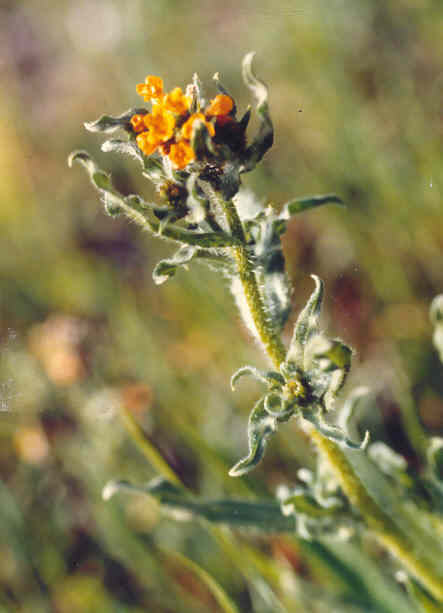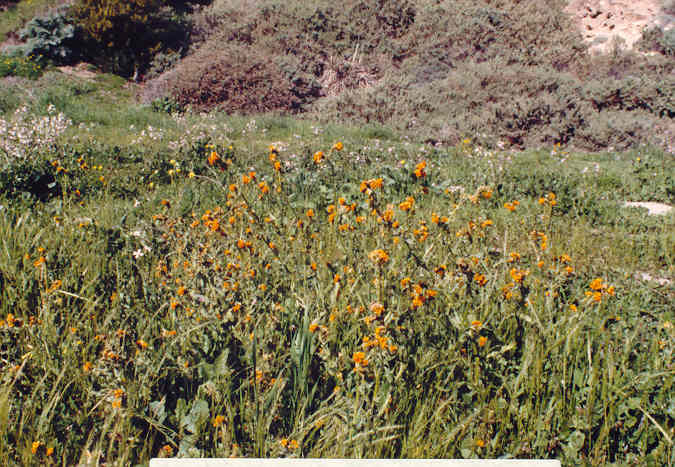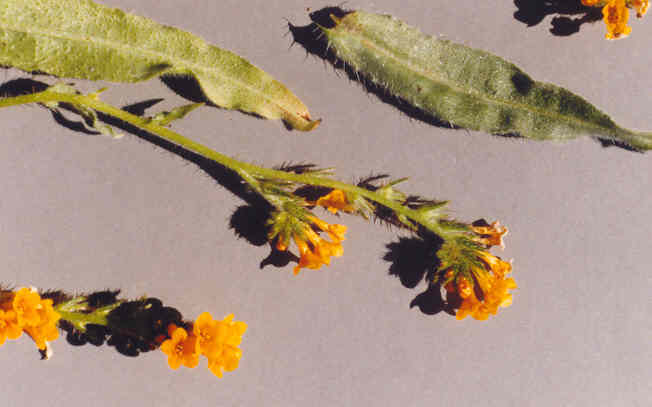
 |
Amsinckia menziesii var. intermedia
(Fischer & C. Meyer) Ganders=Amsinckia intermediaBoraginaceae (Borage Family)Native
Rancher's FireweedFiddleneck |
Plant Characteristics:
Annual herb, erect slender and simple to widely branched, 2-8 dm. tall,
sparsely bristly, otherwise subglabrous except for pubescence toward infl.; lvs.
linear to lanceolate, 2-15 cm. long, the lower petioled, thinly hirsute on both
sides with spreading often pustulate hairs; racemes leafy-bracteate at base,
5-20 cm. long in age; fls. homostylic, nearly radially symmetrical; calyx 5-10
mm. long in fr., 5-lobed, the axial pair of lobes not united, rusty-hispid on
backs, white-hirsute on edges; corolla orange-yellow, 8-10 mm. long, the tube
not much exserted, the limb 2-6 mm. broad, generally with 5 red-orange marks;
nutlets 2-3 mm. long, ovoid or angular-ovoid, tuberculate, usually medially
keeled and with some oblique ridges, usually granulate; scar usually small.
Variable in lf.-shape, pubescence, nutlets; Suksdorf recognizing over 100
segregates.
Habitat:
Many Plant Communities; throughout cismontane Calif., occasional on
deserts; to Wash., Idaho, Ariz., L. Calif.
Below 1700 m. March-June.
Name:
Wilhelm Amsinck, (1752-1831),
early 19th century patron of the botanic garden in Hamburg.
(Munz, Flora So. Calif. 247). Intermedia
is translated as "intermediate".
There are many species of this plant and this one was probably seen as
halfway between two others. (Dale
77). Menziesii, in honor of Archibald Menzies, (1754-1842), surgeon and naturalist to Vancouver's Pacific
Coast expedition. (Jaeger 313).
General:
Common in the study area. Photographed
on the North Star Flats, and on Back Bay Dr. between the Newporter Inn and San
Joaquin Hills Dr. (my
comments). The plant is poisonous to dairy
animals and horses. It contains
alkaloids that cause liver cirrhosis. Without
control, up to 10% of alfalfa seedlings could be destroyed by this plant.
(FREMONTIA, A Journal of the California Native Plant Society, July 85, author
not recorded). There
are records of deleterious effect on hogs, which have been fed large amounts of
the seed, as in barley screenings. (Robbins
et al. 356). Rough as
the plants are to touch, cattle enjoy them and in Arizona they are known as Sacate
Gordo, Spanish for "fat grass". A. intermedia has been known to accumulate free nitrates in
quantities capable of causing death or distress in cattle.
(Fuller 385). Perhaps 20 species of western North
America and southern South America. (Munz,
Flora So. Calif. 247).
Text Ref:
Hickman, Ed. 368; Munz, Calif. Flora 589; Munz, Flora
So. Calif. 248; Roberts 14.
Photo Ref:
Mar 2 85 # 5; Feb-Mar 86 # 7,8.
Identity: by R. De Ruff, confirmed by F. Roberts.
First Found: March 1985.
Computer Ref:
Plant Data 202.
Have plant specimen.
Last edit 5/17/05.
 |
 |